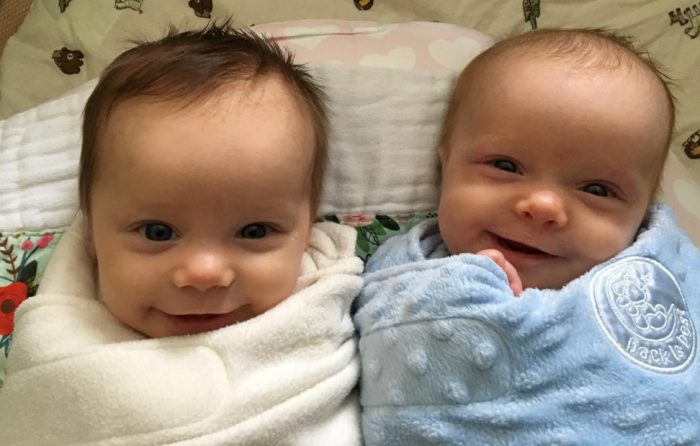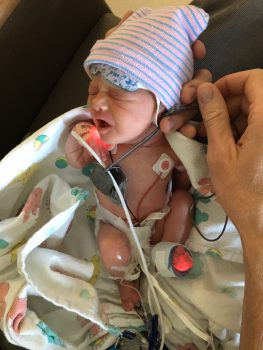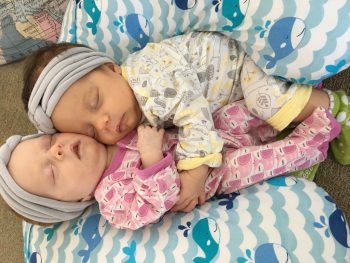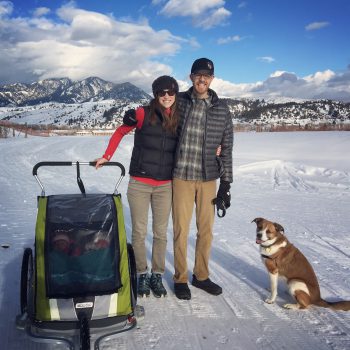
Leigh Sturges recalls the day she and her husband, Zach Sturges, learned they were having twins. Seven weeks into their first pregnancy, the Bozeman, Montana, family entered a state of happy shock.
“We couldn’t believe it when heard two heart beats on the ultrasound,” she said. “We were realistic about the challenges ahead, deciding it could only make us stronger.”
At the time, they had no idea how soon one of those beating hearts would test their strength. It was only days after delivery when doctors detected a congenital heart condition in one twin, leading the Sturgeses to Seattle Children’s Heart Center for an unexpected heart surgery.
Small and seemingly healthy
The Sturgeses welcomed twin daughters, Sabina and Freya, on Sept. 26. Premature at 35 weeks and 5 days, Sabina weighed 3 pounds, 9 ounces and Freya weighed 5 lbs.
“We knew the girls were going to be small because of complications that arose during pregnancy, but we were so happy when both girls appeared healthy,” Zach said.
Sabina and Freya were kept in the hospital while they gained weight, and were preparing to go home after just one week.
“I was on my way home to get the girls’ car seats, when our pediatrician said she wanted to do an echocardiogram (echo) on Sabina’s heart before we were discharged,” Zach said. “Since she was doing so well and had already passed her newborn screening tests, it seemed more like an extra precaution than anything.”
Last-minute screening catches serious heart problem

When Zach returned to the hospital, a familiar face caught him by surprise. Dr. Dennis “Denny” Ruggerie of Seattle Children’s Pediatric Cardiology of Montana was in their suite reading Sabina’s echo.
Zach, an Emergency Department physician at Bozeman Health Deaconess Hospital, the same hospital where the girls were delivered, had interacted with Ruggerie professionally on multiple occasions.
“I’ve known of Denny since I was a medical student,” Zach said. “Still, it was quite a shock to see him there in person.”
Ruggerie happened to be about 60 miles from Bozeman on his way from Great Falls to Yellowstone. When he received the call from the Bozeman Health pediatrics team – a clinic he regularly partners with as one of the few pediatric cardiologists practicing in Montana – he decided to make a detour and visit the hospital in person.
“The team from Bozeman Health deserves a lot of credit for slowing things down and following their instinct when they noticed something wasn’t right,” Ruggerie said. “You couldn’t tell how sick Sabina was from the outside, but something was bubbling up. Her heart was beginning to get into trouble.”
Heart-stopping news
The news Ruggerie delivered to Zach and Leigh during his visit was enough to make any parent’s heart stop.
The echo had detected an aortic coarctation, or extreme aortic narrowing, in Sabina’s heart. This condition develops before birth, making the main blood vessel of the heart shaped like an hourglass. Blood pressure increases above the narrow spot, and the left ventricle of the heart has to pump harder because the pressure is high.
“Sabina’s body was making the necessary adjustments to keep her stable and looking well, but that was not going to last,” Ruggerie said. “Another three days to a week and she would have been showing clear signs of congestive heart failure. Her life would have been at risk.”
The only way to prevent her from becoming critically ill was to get the defect corrected as soon as possible.
Ruggerie told the Sturgeses that Sabina needed emergency transport to a specialized pediatric cardiology center for treatment. He was confident that the team at Seattle Children’s Heart Center – one of the top-ranked pediatric cardiology programs in the United States – would be able to fix her heart and their little girl would be fine.
Urgent flight to Seattle Children’s

The couple decided that Zach would fly with Sabina to Seattle Children’s where his medical background could help navigate her immediate care. Leigh stayed with Freya, making plans for the two of them to join Zach and Sabina in Seattle as soon as possible.
Because of her age, Sabina was first admitted into Seattle Children’s Neonatal Intensive Care Unit (NICU). After a repeat echo in the NICU confirmed the aortic coarctation, Sabina was admitted to the Cardiac Intensive Care Unit (CICU) for further assessment.
When Leigh arrived the following day, Dr. Jonathan Chen, chief of pediatric cardiovascular surgery and co-director of the Seattle Children’s Heart Center, met with the family to discuss their options. He explained how Sabina was too small to undergo balloon dilation through cardiac catheterization, a temporary fix that would delay surgery until she was older. Because Sabina was healthy enough, Chen thought surgery could offer an immediate fix.
“We believe it’s best to provide corrective surgery as soon as possible,” Chen said. “Since Sabina was so small, there are heart centers that would wait for her to gain weight in the NICU before operating, but that carries risks of other health complications.”
“To his credit, Dr. Chen put two extremely nervous first-time parents at absolute ease,” Zach said. “He expressed nothing but optimism that surgery was the best way forward for Sabina. We were totally on board with the operation after speaking to him.”
Open heart surgery at 3 pounds

In surgery, Chen removed the narrow section of Sabina’s aorta and reconnected the ends together. At the time, Sabina’s weight had gone down to 3 pounds.
“This is a relatively common procedure for our team made unique because Sabina was so tiny,” he said.
Despite the shared sense of optimism, it still came as a huge relief for the Sturgeses that Sabina was out of surgery, everything had gone as planned and there were no immediate complications.
“More than anything, I wanted to get the surgery done so that we could move forward as a family,” Leigh said. “Knowing that we were over one hurdle with Sabina, gave me hope that we would all be together back in Montana soon.”
A special time to bond
After surgery, Sabina recovered first in the CICU and then in the NICU. Caring for twins less than 10 days old in separate places meant Zach spent a lot of time in the hospital with Sabina while Leigh took care of Freya from a home they rented in Seattle.
“Those first weeks were hard and chaotic beyond anything I expected as a first-time mom,” Leigh said. “Looking back, I can appreciate that even with all of the challenges, Zach and I had an incredibly special time to individually bond with the babies that I’m not sure we would have had at home.”
With her heart functioning normally, it wasn’t long until Sabina started gaining weight and fully recovered from surgery. By mid-October, she was ready to travel back to Montana with her mom, dad and twin sister.
Making up for lost time

Once home, the Sturgeses took the long-awaited opportunity to find the rhythm of parenthood. Finally, they could experience parenting their twin girls under the same roof.
“Sabina was doing so well by the time we left Seattle Children’s that there wasn’t much we needed to worry about at home other than being the parents of twins,” Leigh said. “I’ve learned that means getting to experience double everything – double the crying and double the smiles.”
At an appointment with Ruggerie in November, Sabina’s echo was normal. She’ll see him again in April for another echo at her local pediatrician’s practice. Seamless access to the Seattle-based Heart Center team and extensive relationships with pediatricians across Big Sky Country are two of the many benefits the Seattle Children’s regional clinic, led by Ruggerie and located in Great Falls, brings to Montana families.
“It’s a big plus knowing that we can see Dr. Ruggerie here in town,” Zach said. “I can’t overemphasize how helpful that is for our family. I think we’ve had enough long distance travel excitement for the immediate future.”
Now at 4 months, Sabina’s outlook is excellent.
“She’s right on target and never lost any ground because of her heart defect,” Chen said. “Sabina or her parents won’t have to worry about her heart in the future. She can do anything she wants.”
Leigh will never forget the support the doctors, nurses, staff and other parents at Seattle Children’s gave her family.
“The whole process was really hard, but at the same time the support we experienced at Seattle Children’s was really beautiful,” she said. “As soon as you put on the orange lanyard that identifies you as a parent or caregiver at the hospital, you share an unforgettable bond with those around you, especially other parents.”
Resources
- Seattle Children’s Heart Center
- Seattle Children’s Pediatric Cardiology of Montana
- Seattle Children’s Neonatology
- Baby Flies Across the Globe for Lifesaving Heart Surgery 24 Hours After Birth

